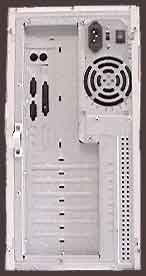Continued from page 1
As a convenience, some cases provide a feature that allows you access to the motherboard without unfastening it from the case. If a portion of the motherboard is inaccessible, especially the memory slots or CPU, look for this feature. It will be on the bottom side of the case, the motherboard may slide or fold out on a tray. Note however that the cables and possibly the installed cards may have to be disconnected to fully access the motherboard.
Opening the Case
 Caution: please read our safety information.
Caution: please read our safety information.
Before opening the case, unplug the PC to avoid an electrical shock hazard. Exercise caution as there are sharp edges on a PC and its components. Always wear a static electricity discharge strap and attach the lead to the metal frame of the case, when working with your PC's components to avoid damaging your PC. Note that some manufacturers will void your PC's warranty if you open the case.
-
Unplug the PC.
-
While not strictly necessary, it is generally advisable to disconnect all of the wires from the back of the PC.
-
Remove the screws or unfasten whatever secures the cover in place.
-
Remove the shell or panel.
The method to open a case varies and it is not always obvious how it is done. A large percentage of cases have the screws on the back, along the perimeter. A plastic cover plate may have to be removed first. It is held in place with snaps and removed by gently tugging a corner. After removing the screws, a "U" shaped shell or a single panel will slide back and off of a tower case or forward (and possibly up) off of a desktop case.

Other designs include a case with the fasteners on the front, behind a removable plastic face plate or toolless designs that use a thumbscrew, sliding lock or simple friction to secure the cover in place. Look for screws along the perimeter of the case or devices that resemble a latch. You may have to do some detective work to figure out how to open your particular case.
When you put the cover back on, note any guide rails or alignment guides that must be matched for the cover to fit securely. Also, be careful not to snag any wires, which can easily be sliced by the case.
Page 2 of 2





